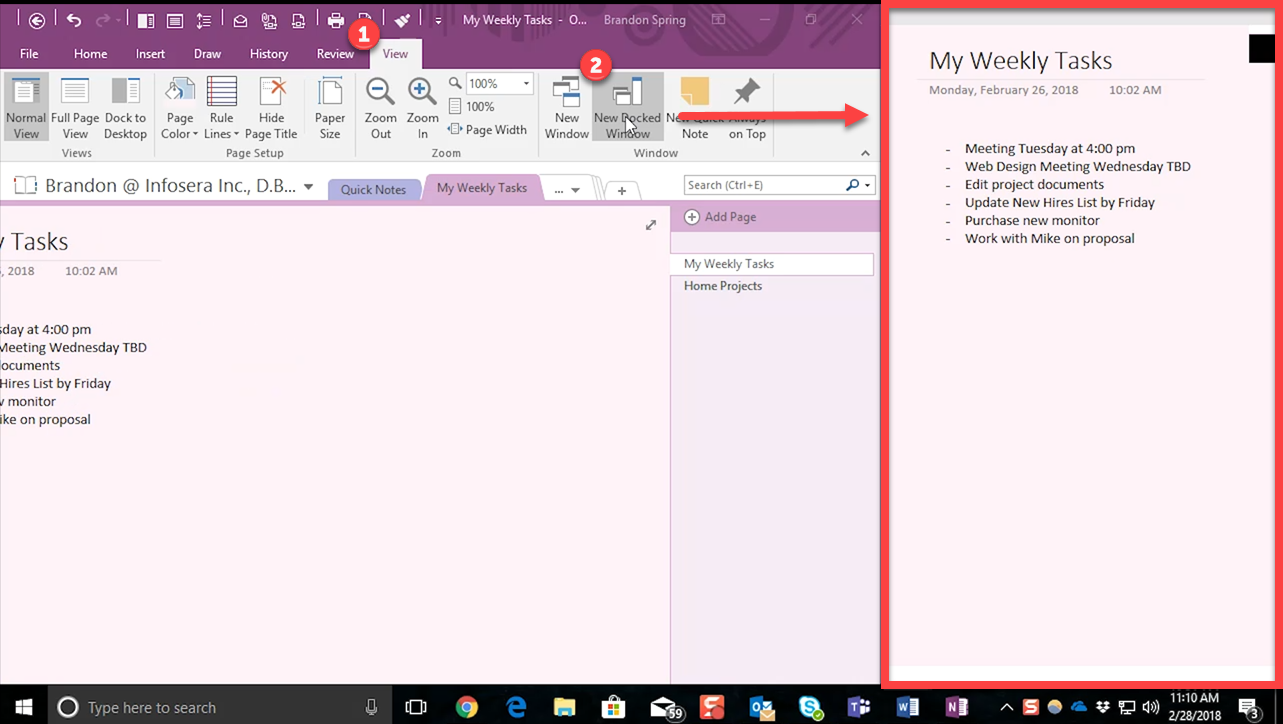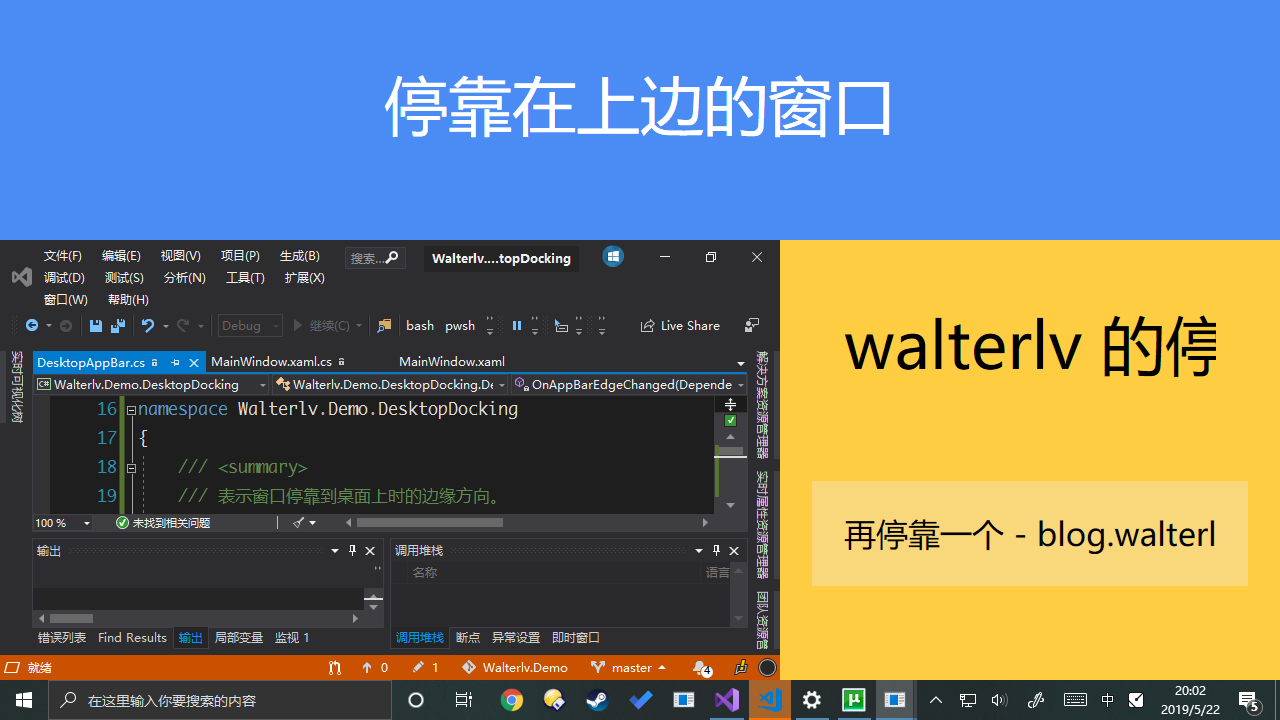WPF 使用 AppBar 将窗口停靠在桌面上,让其他程序不占用此窗口的空间(附我封装的附加属性)
WPF 使用 AppBar 将窗口停靠在桌面上,让其他程序不占用此窗口的空间(附我封装的附加属性)
本文介绍如何使用 Windows 的 AppBar 相关 API 实现固定停靠在桌面上的特殊窗口。
停靠窗口
你可能并不明白停靠窗口是什么意思。
看下图,你可能使用过 OneNote 的停靠窗口功能。当打开一个新的 OneNote 停靠窗口之后,这个新的 OneNote 窗口将固定显示在桌面的右侧,其他的窗口就算最大化也只会占据剩余的空间。
OneNote 的这种功能可以让你在一边浏览网页或做其他事情的时候,以便能够做笔记。同时又不用担心其他窗口最大化的时候会占据记笔记的一部分空间。

这其实也是 Windows 任务栏所使用的方法。
OneNote 中给出的名称叫做“停靠窗口”,于是这可以代表微软希望用户对这个概念的理解名词。
只是,这个概念在 Windows API 中的名称叫做 AppBar。
AppBar
要做出停靠窗口的效果,最核心的 API 是 SHAppBarMessage,用于发送 AppBar 消息给操作系统,以便让操作系统开始处理此窗口已形成一个 AppBar 窗口。也就是我们在用户交互上所说的“停靠窗口”。
虽然说要让一个窗口变成 AppBar 只需要一点点代码,但是要让整个停靠窗口工作得真的像一个停靠窗口,依然需要大量的辅助代码。所以我将其封装成了一个 DesktopAppBar 类,方便 WPF 程序来调用。
如何使用
以下使用,你需要先获取我封装的源码才可以编译通过:
你可以在 XAML 中使用:
1 2 3 4 5 6 7 8 9 10 11 12 13 14 | <Window x:Class="Walterlv.Demo.DesktopDocking.MainWindow" xmlns="http://schemas.microsoft.com/winfx/2006/xaml/presentation" xmlns:x="http://schemas.microsoft.com/winfx/2006/xaml" xmlns:d="http://schemas.microsoft.com/expression/blend/2008" xmlns:mc="http://schemas.openxmlformats.org/markup-compatibility/2006" xmlns:dock="clr-namespace:Walterlv.Demo.DesktopDocking" mc:Ignorable="d" Title="Walterlv 的停靠窗口" Height="450" Width="500" dock:DesktopAppBar.AppBar="Right"> <StackPanel Background="#ffcd42"> <TextBlock FontSize="64" Margin="64" TextAlignment="Center" Text="walterlv 的停靠窗口" /> <Button Content="再停靠一个 - blog.walterlv.com" FontSize="32" Padding="32" Margin="32" Background="#f9d77b" BorderThickness="0" Click="Button_Click"/> </StackPanel> </Window> |
|---|
核心代码是其中的一处属性赋值 dock:DesktopAppBar.AppBar="Right",以及前面的命名空间声明 xmlns:dock="clr-namespace:Walterlv.Demo.DesktopDocking"。
你也可以在 C# 代码中使用:
1 2 3 4 5 6 7 8 9 10 11 12 13 14 15 16 17 18 19 | using System; using System.Windows; namespace Walterlv.Demo.DesktopDocking { public partial class MainWindow : Window { public MainWindow() { InitializeComponent(); } protected override void OnSourceInitialized(EventArgs e) { base.OnSourceInitialized(e); DesktopAppBar.SetAppBar(this, AppBarEdge.Right); } } } |
|---|
使用以上代码中的任何一种方式,你就可以让你的窗口在右边停靠了。

从图中我们可以发现,我们的示例窗口停靠在了右边,其宽度就是我们在 XAML 中设置的窗口宽度(当然这是我封装的逻辑,而不是 AppBar 的原生逻辑)。
同时我们还能注意到,Visual Studio 的窗口是处于最大化的状态的——这是停靠窗口的最大优势——可以让其他窗口的工作区缩小,在最大化的时候不会覆盖到停靠窗口的内容。
另外,如果设置了第二个停靠窗口,那么第二个停靠窗口会挤下第一个窗口的位置。

如何还原
Windows AppBar 的 API 有一个很不好的设定,如果进程退出了,那么 AppBar 所占用的空间 并不会还原!!!
不过不用担心,我在封装的代码里面加入了窗口关闭时还原空间的代码,如果你正常关闭窗口,那么停靠窗口占用的空间就会及时还原回来。
当然,你也可以适时调用下面的代码:
1 | DesktopAppBar.SetAppBar(this, AppBarEdge.None); |
|---|
附源码
由于源码一直在持续改进,所以本文中贴的源代码可能不是最新的。你可以在以下仓库找到这段源码的最新版本:
1 2 3 4 5 6 7 8 9 10 11 12 13 14 15 16 17 18 19 20 21 22 23 24 25 26 27 28 29 30 31 32 33 34 35 36 37 38 39 40 41 42 43 44 45 46 47 48 49 50 51 52 53 54 55 56 57 58 59 60 61 62 63 64 65 66 67 68 69 70 71 72 73 74 75 76 77 78 79 80 81 82 83 84 85 86 87 88 89 90 91 92 93 94 95 96 97 98 99 100 101 102 103 104 105 106 107 108 109 110 111 112 113 114 115 116 117 118 119 120 121 122 123 124 125 126 127 128 129 130 131 132 133 134 135 136 137 138 139 140 141 142 143 144 145 146 147 148 149 150 151 152 153 154 155 156 157 158 159 160 161 162 163 164 165 166 167 168 169 170 171 172 173 174 175 176 177 178 179 180 181 182 183 184 185 186 187 188 189 190 191 192 193 194 195 196 197 198 199 200 201 202 203 204 205 206 207 208 209 210 211 212 213 214 215 216 217 218 219 220 221 222 223 224 225 226 227 228 229 230 231 232 233 234 235 236 237 238 239 240 241 242 243 244 245 246 247 248 249 250 251 252 253 254 255 256 257 258 259 260 261 262 263 264 265 266 267 268 269 270 271 272 273 274 275 276 277 278 279 280 281 282 283 284 285 286 287 288 289 290 291 292 293 294 295 296 297 298 299 300 301 302 303 304 305 306 307 308 309 310 311 312 313 314 315 316 317 318 319 320 321 322 323 324 325 326 327 328 329 330 331 332 333 334 335 336 337 338 339 340 341 342 343 344 345 346 347 348 349 350 351 352 353 354 355 356 357 358 359 360 361 362 363 364 365 366 367 368 369 370 | using System; using System.ComponentModel; using System.Diagnostics.CodeAnalysis; using System.Runtime.InteropServices; using System.Threading.Tasks; using System.Windows; using System.Windows.Interop; // ReSharper disable IdentifierTypo // ReSharper disable InconsistentNaming // ReSharper disable EnumUnderlyingTypeIsInt // ReSharper disable MemberCanBePrivate.Local // ReSharper disable UnusedMember.Local // ReSharper disable UnusedMember.Global namespace Walterlv.Demo.DesktopDocking { /// <summary> /// 表示窗口停靠到桌面上时的边缘方向。 /// </summary> public enum AppBarEdge { /// <summary> /// 窗口停靠到桌面的左边。 /// </summary> Left = 0, /// <summary> /// 窗口停靠到桌面的顶部。 /// </summary> Top, /// <summary> /// 窗口停靠到桌面的右边。 /// </summary> Right, /// <summary> /// 窗口停靠到桌面的底部。 /// </summary> Bottom, /// <summary> /// 窗口不停靠到任何方向,而是成为一个普通窗口占用剩余的可用空间(工作区)。 /// </summary> None } /// <summary> /// 提供将窗口停靠到桌面某个方向的能力。 /// </summary> public class DesktopAppBar { /// <summary> /// 标识 Window.AppBar 的附加属性。 /// </summary> public static readonly DependencyProperty AppBarProperty = DependencyProperty.RegisterAttached( "AppBar", typeof(AppBarEdge), typeof(DesktopAppBar), new PropertyMetadata(AppBarEdge.None, OnAppBarEdgeChanged)); /// <summary> /// 获取 <paramref name="window"/> 当前的停靠边缘。 /// </summary> /// <param name="window">要获取停靠边缘的窗口。</param> /// <returns>停靠边缘。</returns> public static AppBarEdge GetAppBar(Window window) => (AppBarEdge)window.GetValue(AppBarProperty); /// <summary> /// 设置 <paramref name="window"/> 的停靠边缘方向。 /// </summary> /// <param name="window">要设置停靠的窗口。</param> /// <param name="value">要设置的停靠边缘方向。</param> public static void SetAppBar(Window window, AppBarEdge value) => window.SetValue(AppBarProperty, value); private static readonly DependencyProperty AppBarProcessorProperty = DependencyProperty.RegisterAttached( "AppBarProcessor", typeof(AppBarWindowProcessor), typeof(DesktopAppBar), new PropertyMetadata(null)); [SuppressMessage("ReSharper", "ConditionIsAlwaysTrueOrFalse")] private static void OnAppBarEdgeChanged(DependencyObject d, DependencyPropertyChangedEventArgs e) { if (DesignerProperties.GetIsInDesignMode(d)) { return; } var oldValue = (AppBarEdge) e.OldValue; var newValue = (AppBarEdge) e.NewValue; var oldEnabled = oldValue is AppBarEdge.Left || oldValue is AppBarEdge.Top || oldValue is AppBarEdge.Right || oldValue is AppBarEdge.Bottom; var newEnabled = newValue is AppBarEdge.Left || newValue is AppBarEdge.Top || newValue is AppBarEdge.Right || newValue is AppBarEdge.Bottom; if (oldEnabled && !newEnabled) { var processor = (AppBarWindowProcessor) d.GetValue(AppBarProcessorProperty); processor.Detach(); } else if (!oldEnabled && newEnabled) { var processor = new AppBarWindowProcessor((Window) d); d.SetValue(AppBarProcessorProperty, processor); processor.Attach(newValue); } else if (oldEnabled && newEnabled) { var processor = (AppBarWindowProcessor) d.GetValue(AppBarProcessorProperty); processor.Update(newValue); } } /// <summary> /// 包含对 <see cref="Window"/> 进行操作以便使其成为一个桌面停靠窗口的能力。 /// </summary> private class AppBarWindowProcessor { /// <summary> /// 创建 <see cref="AppBarWindowProcessor"/> 的新实例。 /// </summary> /// <param name="window">需要成为停靠窗口的 <see cref="Window"/> 的实例。</param> public AppBarWindowProcessor(Window window) { _window = window; _callbackId = RegisterWindowMessage("AppBarMessage"); _hwndSourceTask = new TaskCompletionSource<HwndSource>(); var source = (HwndSource) PresentationSource.FromVisual(window); if (source == null) { window.SourceInitialized += OnSourceInitialized; } else { _hwndSourceTask.SetResult(source); } _window.Closed += OnClosed; } private readonly Window _window; private readonly TaskCompletionSource<HwndSource> _hwndSourceTask; private readonly int _callbackId; private WindowStyle _restoreStyle; private Rect _restoreBounds; private ResizeMode _restoreResizeMode; private bool _restoreTopmost; private AppBarEdge Edge { get; set; } /// <summary> /// 在可以获取到窗口句柄的时候,给窗口句柄设置值。 /// </summary> private void OnSourceInitialized(object sender, EventArgs e) { _window.SourceInitialized -= OnSourceInitialized; var source = (HwndSource) PresentationSource.FromVisual(_window); _hwndSourceTask.SetResult(source); } /// <summary> /// 在窗口关闭之后,需要恢复窗口设置过的停靠属性。 /// </summary> private void OnClosed(object sender, EventArgs e) { _window.Closed -= OnClosed; _window.ClearValue(AppBarProperty); } /// <summary> /// 将窗口属性设置为停靠所需的属性。 /// </summary> private void ForceWindowProperties() { _window.WindowStyle = WindowStyle.None; _window.ResizeMode = ResizeMode.NoResize; _window.Topmost = true; } /// <summary> /// 备份窗口在成为停靠窗口之前的属性。 /// </summary> private void BackupWindowProperties() { _restoreStyle = _window.WindowStyle; _restoreBounds = _window.RestoreBounds; _restoreResizeMode = _window.ResizeMode; _restoreTopmost = _window.Topmost; } /// <summary> /// 使一个窗口开始成为桌面停靠窗口,并开始处理窗口停靠消息。 /// </summary> /// <param name="value">停靠方向。</param> public async void Attach(AppBarEdge value) { var hwndSource = await _hwndSourceTask.Task; BackupWindowProperties(); var data = new APPBARDATA(); data.cbSize = Marshal.SizeOf(data); data.hWnd = hwndSource.Handle; data.uCallbackMessage = _callbackId; SHAppBarMessage((int) ABMsg.ABM_NEW, ref data); hwndSource.AddHook(WndProc); Update(value); } /// <summary> /// 更新一个窗口的停靠方向。 /// </summary> /// <param name="value">停靠方向。</param> public async void Update(AppBarEdge value) { var hwndSource = await _hwndSourceTask.Task; Edge = value; var bounds = TransformToAppBar(hwndSource.Handle, _window.RestoreBounds, value); ForceWindowProperties(); Resize(_window, bounds); } /// <summary> /// 使一个窗口从桌面停靠窗口恢复成普通窗口。 /// </summary> public async void Detach() { var hwndSource = await _hwndSourceTask.Task; var data = new APPBARDATA(); data.cbSize = Marshal.SizeOf(data); data.hWnd = hwndSource.Handle; SHAppBarMessage((int) ABMsg.ABM_REMOVE, ref data); _window.WindowStyle = _restoreStyle; _window.ResizeMode = _restoreResizeMode; _window.Topmost = _restoreTopmost; Resize(_window, _restoreBounds); } private IntPtr WndProc(IntPtr hwnd, int msg, IntPtr wParam, IntPtr lParam, ref bool handled) { if (msg == _callbackId) { if (wParam.ToInt32() == (int) ABNotify.ABN_POSCHANGED) { var hwndSource = _hwndSourceTask.Task.Result; var bounds = TransformToAppBar(hwndSource.Handle, _window.RestoreBounds, Edge); Resize(_window, bounds); handled = true; } } return IntPtr.Zero; } private static void Resize(Window window, Rect bounds) { window.Left = bounds.Left; window.Top = bounds.Top; window.Width = bounds.Width; window.Height = bounds.Height; } private Rect TransformToAppBar(IntPtr hWnd, Rect area, AppBarEdge edge) { var data = new APPBARDATA(); data.cbSize = Marshal.SizeOf(data); data.hWnd = hWnd; data.uEdge = (int) edge; if (data.uEdge == (int) AppBarEdge.Left || data.uEdge == (int) AppBarEdge.Right) { data.rc.top = 0; data.rc.bottom = (int) SystemParameters.PrimaryScreenHeight; if (data.uEdge == (int) AppBarEdge.Left) { data.rc.left = 0; data.rc.right = (int) Math.Round(area.Width); } else { data.rc.right = (int) SystemParameters.PrimaryScreenWidth; data.rc.left = data.rc.right - (int) Math.Round(area.Width); } } else { data.rc.left = 0; data.rc.right = (int) SystemParameters.PrimaryScreenWidth; if (data.uEdge == (int) AppBarEdge.Top) { data.rc.top = 0; data.rc.bottom = (int) Math.Round(area.Height); } else { data.rc.bottom = (int) SystemParameters.PrimaryScreenHeight; data.rc.top = data.rc.bottom - (int) Math.Round(area.Height); } } SHAppBarMessage((int) ABMsg.ABM_QUERYPOS, ref data); SHAppBarMessage((int) ABMsg.ABM_SETPOS, ref data); return new Rect(data.rc.left, data.rc.top, data.rc.right - data.rc.left, data.rc.bottom - data.rc.top); } [StructLayout(LayoutKind.Sequential)] private struct RECT { public int left; public int top; public int right; public int bottom; } [StructLayout(LayoutKind.Sequential)] private struct APPBARDATA { public int cbSize; public IntPtr hWnd; public int uCallbackMessage; public int uEdge; public RECT rc; public readonly IntPtr lParam; } private enum ABMsg : int { ABM_NEW = 0, ABM_REMOVE, ABM_QUERYPOS, ABM_SETPOS, ABM_GETSTATE, ABM_GETTASKBARPOS, ABM_ACTIVATE, ABM_GETAUTOHIDEBAR, ABM_SETAUTOHIDEBAR, ABM_WINDOWPOSCHANGED, ABM_SETSTATE } private enum ABNotify : int { ABN_STATECHANGE = 0, ABN_POSCHANGED, ABN_FULLSCREENAPP, ABN_WINDOWARRANGE } [DllImport("SHELL32", CallingConvention = CallingConvention.StdCall)] private static extern uint SHAppBarMessage(int dwMessage, ref APPBARDATA pData); [DllImport("User32.dll", CharSet = CharSet.Auto)] private static extern int RegisterWindowMessage(string msg); } } } |
|---|
参考资料
- c# - How do you do AppBar docking (to screen edge, like WinAmp) in WPF? - Stack Overflow
- mgaffigan/WpfAppBar: AppBar implementation for WPF
- .net - How to dock an application in the Windows desktop? - Stack Overflow
- AppBar using C# - CodeProject
- SHAppBarMessage function (shellapi.h) - Microsoft Docs
- RegisterWindowMessageA function (winuser.h) - Microsoft Docs
本文会经常更新,请阅读原文: https://blog.walterlv.com/post/dock-window-into-windows-desktop.html ,以避免陈旧错误知识的误导,同时有更好的阅读体验。
本作品采用 知识共享署名-非商业性使用-相同方式共享 4.0 国际许可协议 进行许可。欢迎转载、使用、重新发布,但务必保留文章署名 吕毅 (包含链接: https://blog.walterlv.com ),不得用于商业目的,基于本文修改后的作品务必以相同的许可发布。如有任何疑问,请 与我联系 ([email protected]) 。
- 停靠窗口
- AppBar
- 如何使用
- 如何还原
- 附源码

腾讯云开发者

扫码关注腾讯云开发者
领取腾讯云代金券
Copyright © 2013 - 2025 Tencent Cloud. All Rights Reserved. 腾讯云 版权所有
深圳市腾讯计算机系统有限公司 ICP备案/许可证号:粤B2-20090059 深公网安备号 44030502008569
腾讯云计算(北京)有限责任公司 京ICP证150476号 | 京ICP备11018762号 | 京公网安备号11010802020287
Copyright © 2013 - 2025 Tencent Cloud.
All Rights Reserved. 腾讯云 版权所有
